Eco-Friendly NiO/Polydopamine Nanocomposite for Efficient Removal of Dyes from Wastewater
Abstract
:1. Introduction
2. Materials and Methods
2.1. Materials
2.2. Characterization Tools
2.3. Synthesis of Nano-NiO
2.4. Synthesis of NiO/PDA Nanocomposite
2.5. Removal of MV2B by Batch Mode Technique
3. Results and Discussion
3.1. NiO/PDA Characterization
3.1.1. Fourier Transform Infrared Spectroscopy (FT-IR)
3.1.2. X-ray Diffraction Pattern (XRD)
3.1.3. Scanning Electron Microscopy (SEM) and Energy Dispersive X-ray Analysis (EDX)
3.1.4. Transmission Electron Microscopy (TEM)
3.1.5. Brunauer–Emmett–Teller (BET)
3.2. Adsorption Efficiency of NiO/PDA
3.2.1. Effect of NiO/PDA Dose
3.2.2. Effect of (MV2B)o
3.3. Adsorption Kinetics
3.3.1. Pseudo-First-Order Kinetic Model
3.3.2. Pseudo-Second-Order Kinetic Model
3.3.3. Intraparticle Diffusion Model
3.3.4. Elovich Kinetic Model
3.4. Adsorption Isotherms
3.4.1. Langmuir Isotherm
3.4.2. Freundlich Isotherm
3.4.3. Dubinin–Radushkevich (D–R) Isotherm
3.5. Effect of pH
3.6. Reusability
4. Conclusions
Author Contributions
Funding
Institutional Review Board Statement
Informed Consent Statement
Data Availability Statement
Acknowledgments
Conflicts of Interest
References
- Srivastava, A.; Rani, R.M.; Patle, D.S.; Kumar, S. Emerging bioremediation technologies for the treatment of textile wastewater containing synthetic dyes: A comprehensive review. J. Chem. Technol. Biotechnol. 2022, 97, 26–41. [Google Scholar] [CrossRef]
- Emamjomeh, M.M.; Sivakumar, M. Review of pollutants removed by electrocoagulation and electrocoagulation/flotation processes. J. Environ. Manag. 2009, 90, 1663–1679. [Google Scholar] [CrossRef] [PubMed]
- Wang, J.; Chen, H. Catalytic ozonation for water and wastewater treatment: Recent advances and perspective. Sci. Total Environ. 2020, 704, 135249. [Google Scholar] [CrossRef] [PubMed]
- Salem, I.A.; El-Ghamry, H.A.; El-Ghobashy, M.A. Application of montmorillonite–Cu (II) ethylenediamine catalyst for the decolorization of Chromotrope 2R with H2O2 in aqueous solution. Spectrochim. Acta A Mol. Biomol. Spectrosc. 2015, 139, 130–137. [Google Scholar] [CrossRef] [PubMed]
- Elmorsi, T.M.; Riyad, Y.M.; Mohamed, Z.H.; El Bary, H.M.A. Decolorization of Mordant red 73 azo dye in water using H2O2/UV and photo-Fenton treatment. J. Hazard. Mater. 2010, 174, 352–358. [Google Scholar] [CrossRef] [PubMed]
- Cui, D.; Guo, Y.-Q.; Cheng, H.-Y.; Liang, B.; Kong, F.-Y.; Lee, H.-S.; Wang, A.-J. Azo dye removal in a membrane-free up-flow biocatalyzed electrolysis reactor coupled with an aerobic bio-contact oxidation reactor. J. Hazard. Mater. 2012, 239, 257–264. [Google Scholar] [CrossRef] [PubMed]
- Behnajady, M.A.; Bimeghdar, S. Synthesis of mesoporous NiO nanoparticles and their application in the adsorption of Cr (VI). Chem. Eng. J. 2014, 239, 105–113. [Google Scholar] [CrossRef]
- Jadhav, H.S.; Thorat, G.M.; Mun, J.; Seo, J.G. Self-assembled hierarchical 3D–NiO microspheres with ultra-thin porous nanoflakes for lithium-ion batteries. J. Power Sources 2016, 302, 13–21. [Google Scholar] [CrossRef]
- Tian, K.; Wang, X.-X.; Li, H.-Y.; Nadimicherla, R.; Guo, X. Lotus pollen derived 3-dimensional hierarchically porous NiO microspheres for NO2 gas sensing. Sens. Actuators B 2016, 227, 554–560. [Google Scholar] [CrossRef]
- Cheng, G.; Yang, W.; Dong, C.; Kou, T.; Bai, Q.; Wang, H.; Zhang, Z. Ultrathin mesoporous NiO nanosheet-anchored 3D nickel foam as an advanced electrode for supercapacitors. J. Mater. Chem. A 2015, 3, 17469–17478. [Google Scholar] [CrossRef]
- Ye, Y.; Zhao, Y.; Ni, L.; Jiang, K.; Tong, G.; Zhao, Y.; Teng, B. Facile synthesis of unique NiO nanostructures for efficiently catalytic conversion of CH4 at low temperature. Appl. Surf. Sci. 2016, 362, 20–27. [Google Scholar] [CrossRef]
- Zheng, Y.; Zhu, B.; Chen, H.; You, W.; Jiang, C.; Yu, J. Hierarchical flower-like nickel (II) oxide microspheres with high adsorption capacity of Congo red in water. J. Colloid Interf. Sci. 2017, 504, 688–696. [Google Scholar] [CrossRef] [PubMed]
- Mahmoud, A.M.; Ibrahim, F.A.; Shaban, S.A.; Youssef, N.A. Adsorption of heavy metal ion from aqueous solution by nickel oxide nano catalyst prepared by different methods. Egypt. J. Petrol. 2015, 24, 27–35. [Google Scholar] [CrossRef] [Green Version]
- Sheshdeh, R.K.; Nikou, M.R.K.; Badii, K.; Limaee, N.Y.; Golkarnarenji, G. Equilibrium and kinetics studies for the adsorption of Basic Red 46 on nickel oxide nanoparticles-modified diatomite in aqueous solutions. J. Taiwan Inst. Chem. E 2014, 45, 1792–1802. [Google Scholar] [CrossRef]
- Kitchamsetti, N.; Ramteke, M.S.; Rondiya, S.R.; Mulani, S.R.; Patil, M.S.; Cross, R.W.; Dzade, N.Y.; Devan, R.S. DFT and experimental investigations on the photocatalytic activities of NiO nanobelts for removal of organic pollutants. J. Alloys Compd. 2021, 855, 157337. [Google Scholar] [CrossRef]
- Riaz, Q.; Ahmed, M.; Zafar, M.N.; Zubair, M.; Nazar, M.F.; Sumrra, S.H.; Ahmad, I.; Hosseini-Bandegharaei, A. NiO nanoparticles for enhanced removal of methyl orange: Equilibrium, kinetics, thermodynamic and desorption studies. Int. J. Env. Anal. Chem. 2022, 102, 84–103. [Google Scholar] [CrossRef]
- Gao, S.; Wang, D.; Huang, Z.; Su, C.; Chen, M.; Lin, X. Recyclable NiO/sepiolite as adsorbent to remove organic dye and its regeneration. Sci. Rep. 2022, 12, 2895. [Google Scholar] [CrossRef] [PubMed]
- Koohi, P.; Rahbar-kelishami, A.; Shayesteh, H. Efficient removal of congo red dye using Fe3O4/NiO nanocomposite: Synthesis and characterization. Env. Techn. Innov. 2021, 23, 101559. [Google Scholar] [CrossRef]
- Xie, Y.; Yan, B.; Xu, H.; Chen, J.; Liu, Q.; Deng, Y.; Zeng, H. Highly regenerable mussel-inspired Fe3O4@ polydopamine-Ag core–shell microspheres as catalyst and adsorbent for methylene blue removal. ACS Appl. Mater. Interf. 2014, 6, 8845–8852. [Google Scholar] [CrossRef] [PubMed]
- Gao, H.; Sun, Y.; Zhou, J.; Xu, R.; Duan, H. Mussel-inspired synthesis of polydopamine-functionalized graphene hydrogel as reusable adsorbents for water purification. ACS Appl. Mater. Interf. 2013, 5, 425–432. [Google Scholar] [CrossRef] [PubMed]
- Kong, J.; Shahabadi, S.I.S.; Lu, X. Integration of inorganic nanostructures with polydopamine-derived carbon: Tunable morphologies and versatile applications. Nanoscale 2016, 8, 1770–1788. [Google Scholar] [CrossRef] [PubMed]
- Liu, Y.; Ai, K.; Lu, L. Polydopamine and its derivative materials: Synthesis and promising applications in energy, environmental, and biomedical fields. Chem. Rev. 2014, 114, 5057–5115. [Google Scholar] [CrossRef]
- Li, G.-J.; Huang, X.-X.; Shi, Y.; Guo, J.-K. Preparation and characteristics of nanocrystalline NiO by organic solvent method. Mater. Lett. 2001, 51, 325–330. [Google Scholar] [CrossRef]
- Zhou, M.; Xu, D. Starch-MMT composite films: Effects of bio-inspired modification on MMT. Starch-Staerke 2015, 67, 470–477. [Google Scholar] [CrossRef]
- Chen, S.; Xu, H.; He, X.; Su, Y.; Liu, Q.; Zhang, B. One-pot synthesis of polydopamine/Ag microspheres through microemulsion environment and its methylene blue removal application. J. Polym. Res. 2022, 29, 34. [Google Scholar] [CrossRef]
- Chen, X.; Deng, E.; Lin, X.; Tandel, A.M.; Rub, D.; Zhu, L.; Huang, L.; Lin, H. Engineering hierarchical nanochannels in graphene oxide membranes by etching and polydopamine intercalation for highly efficient dye recovery. Chem. Eng. J. 2022, 433, 133593. [Google Scholar] [CrossRef]
- Huang, T.; Cao, S.; Luo, D.; Zhang, N.; Lei, Y.-z.; Wang, Y. Polydopamine-assisted polyethylenimine grafting melamine foam and the application in wastewater purification. Chemosphere 2022, 287, 132054. [Google Scholar] [CrossRef] [PubMed]
- Zhou, M.; Liu, Q.; Wu, S.; Gou, Z.; Wu, X.; Xu, D. Starch/chitosan films reinforced with polydopamine modified MMT: Effects of dopamine concentration. Food Hydrocoll. 2016, 61, 678–684. [Google Scholar] [CrossRef]
- Shuihab, A.; Khalf, S. Fabrication and Characterization of Nickel Oxide Nanoparticles/silicon NiO NPS/Si. In AIP Conference Proceedings; AIP Publishing LLC: Melville, NY, USA, 2018; p. 020026. [Google Scholar] [CrossRef]
- Yan, D.; Xu, P.; Xiang, Q.; Mou, H.; Xu, J.; Wen, W.; Li, X.; Zhang, Y. Polydopamine nanotubes: Bio-inspired synthesis, formaldehyde sensing properties and thermodynamic investigation. J. Mater. Chem. A 2016, 4, 3487–3493. [Google Scholar] [CrossRef]
- Zhang, M.; Zhang, X.; He, X.; Chen, L.; Zhang, Y. A self-assembled polydopamine film on the surface of magnetic nanoparticles for specific capture of protein. Nanoscale 2012, 4, 3141–3147. [Google Scholar] [CrossRef]
- Wei, Z.; Qiao, H.; Yang, H.; Zhang, C.; Yan, X. Characterization of NiO nanoparticles by anodic arc plasma method. J. Alloys Compd. 2009, 479, 855–858. [Google Scholar] [CrossRef]
- Luo, H.; Gu, C.; Zheng, W.; Dai, F.; Wang, X.; Zheng, Z. Facile synthesis of novel size-controlled antibacterial hybrid spheres using silver nanoparticles loaded with poly-dopamine spheres. RSC Adv. 2015, 5, 13470–13477. [Google Scholar] [CrossRef]
- Zhu, T.; Chen, J.S.; Lou, X.W. Highly efficient removal of organic dyes from waste water using hierarchical NiO spheres with high surface area. J. Phys. Chem. C 2012, 116, 6873–6878. [Google Scholar] [CrossRef]
- Jing, C.; Liu, X.; Liu, X.; Jiang, D.; Dong, B.; Dong, F.; Wang, J.; Li, N.; Lan, T.; Zhang, Y. Crystal morphology evolution of Ni–Co layered double hydroxide nanostructure towards high-performance biotemplate asymmetric supercapacitors. CrystEngComm 2018, 20, 7428–7434. [Google Scholar] [CrossRef]
- Nistor, M.-A.; Muntean, S.G.; Ianoș, R.; Racoviceanu, R.; Ianași, C.; Cseh, L. Adsorption of anionic dyes from wastewater onto magnetic nanocomposite powders synthesized by combustion method. Appl. Sci. 2021, 11, 9236. [Google Scholar] [CrossRef]
- Soliman, N.K.; Moustafa, A.F.; Abd El-Mageed, H.R.; Abdel-Gawad, O.F.; Elkady, E.T.; Ahmed, S.A.; Mohamed, H.S. Experimentally and theoretically approaches for disperse red 60 dye adsorption on novel quaternary nanocomposites. Sci. Rep. 2021, 11, 10000. [Google Scholar] [CrossRef] [PubMed]
- Dutta, S.; Gupta, B.; Srivastava, S.K.; Gupta, A.K. Recent advances on the removal of dyes from wastewater using various adsorbents: A critical review. Mater. Adv. 2021, 2, 4497–4531. [Google Scholar] [CrossRef]
- Mahamadi, C.; Mawere, E. Kinetic modeling of methylene blue and crystal violet dyes adsorption on alginate-fixed water hyacinth in single and binary systems. Amer. J. Anal. Chem. 2013, 4, 17–24. [Google Scholar] [CrossRef] [Green Version]
- Wang, Y.; Zhang, Y.; Hou, C.; Liu, M. Mussel-inspired synthesis of magnetic polydopamine–chitosan nanoparticles as biosorbent for dyes and metals removal. J Taiwan Inst. Chem. E 2016, 61, 292–298. [Google Scholar] [CrossRef]
- Wang, K.; Fu, J.; Wang, S.; Gao, M.; Zhu, J.; Wang, Z.; Xu, Q. Polydopamine-coated magnetic nanochains as efficient dye adsorbent with good recyclability and magnetic separability. J. Coll. Interf. Sci. 2018, 516, 263–273. [Google Scholar] [CrossRef] [PubMed]
- Deng, J.; Lei, B.; He, A.; Zhang, X.; Ma, L.; Li, S.; Zhao, C. Toward 3D graphene oxide gels based adsorbents for high-efficient water treatment via the promotion of biopolymers. J. Hazard. Mater. 2013, 263, 467–478. [Google Scholar] [CrossRef]
- Gedam, V.V.; Raut, P.; Chahande, A.; Pathak, P. Kinetic, thermodynamics and equilibrium studies on the removal of Congo red dye using activated teak leaf powder. Appl. Wat. Sci. 2019, 9, 55. [Google Scholar] [CrossRef] [Green Version]
- Olajire, A.; Giwa, A.; Bello, I. Competitive adsorption of dye species from aqueous solution onto melon husk in single and ternary dye systems. Int. J. Env. Sci. Techn. 2015, 12, 939–950. [Google Scholar] [CrossRef] [Green Version]
- Salem, I.A.; Salem, M.A.; El-Ghobashy, M.A. The dual role of ZnO nanoparticles for efficient capture of heavy metals and Acid blue 92 from water. J. Mol. Liq. 2017, 248, 527–538. [Google Scholar] [CrossRef]
- Anaia, G.C.; Freitas, P.A.; Suárez-Iha, M.E.; Rocha, F.R. Adsorption of 1-(2-thiazolylazo)-2-naphthol on amberlite XAD-7 and silica gel: Isotherms and kinetic studies. J. Braz. Chem. Soc. 2014, 25, 648–657. [Google Scholar] [CrossRef]
- Özcan, A.S.; Erdem, B.; Özcan, A. Adsorption of Acid Blue 193 from aqueous solutions onto Na–bentonite and DTMA–bentonite. J. Coll. Interf. Sci. 2004, 280, 44–54. [Google Scholar] [CrossRef]
- Jiang, J.-Q.; Cooper, C.; Ouki, S. Comparison of modified montmorillonite adsorbents: Part I: Preparation, characterization and phenol adsorption. Chemosphere 2002, 47, 711–716. [Google Scholar] [CrossRef]
- Radjenovic, A.; Medunic, G. Removal of Cr(VI) from aqueous solution by a commercial carbon black. Desalin. Water Treat. 2015, 55, 183–192. [Google Scholar] [CrossRef]
- Helfferich, F.; Dranoff, J. Ion Exchange; McGraw-Hill: New York, NY, USA, 1962; 624p, Pergamon. [Google Scholar]
- Zhang, Q.; Yang, Q.; Phanlavong, P.; Li, Y.; Wang, Z.; Jiao, T.; Peng, Q. Highly efficient lead (II) sequestration using size-controllable polydopamine microspheres with superior application capability and rapid capture. ACS Sustain. Chem. Eng. 2017, 5, 4161–4170. [Google Scholar] [CrossRef]
- Fu, J.; Chen, Z.; Wang, M.; Liu, S.; Zhang, J.; Zhang, J.; Han, R.; Xu, Q. Adsorption of methylene blue by a high-efficiency adsorbent (polydopamine microspheres): Kinetics, isotherm, thermodynamics and mechanism analysis. Chem. Eng. J. 2015, 259, 53–61. [Google Scholar] [CrossRef]
- Chen, P.; Cao, Z.-F.; Wang, S.; Zhong, H. In situ nano-silicate functionalized magnetic composites by (poly) dopamine to improve MB removal. Colloids Surf. A 2018, 552, 89–97. [Google Scholar] [CrossRef]
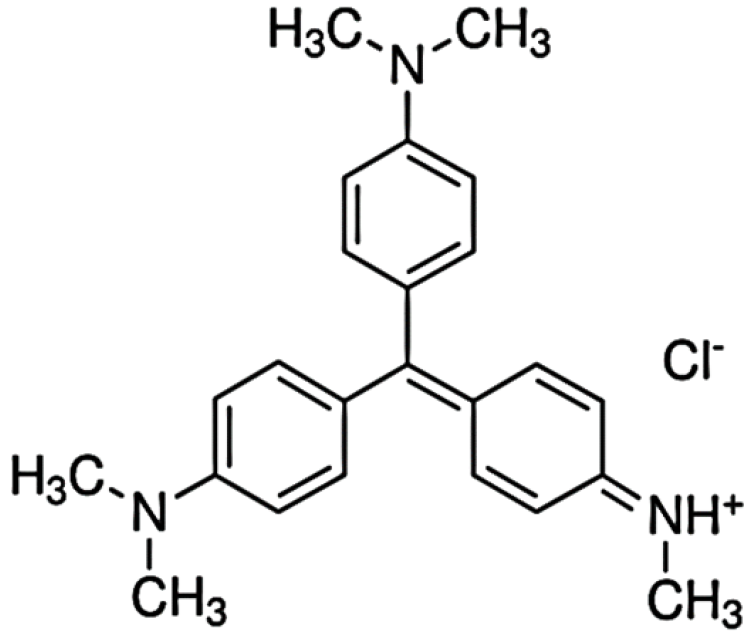
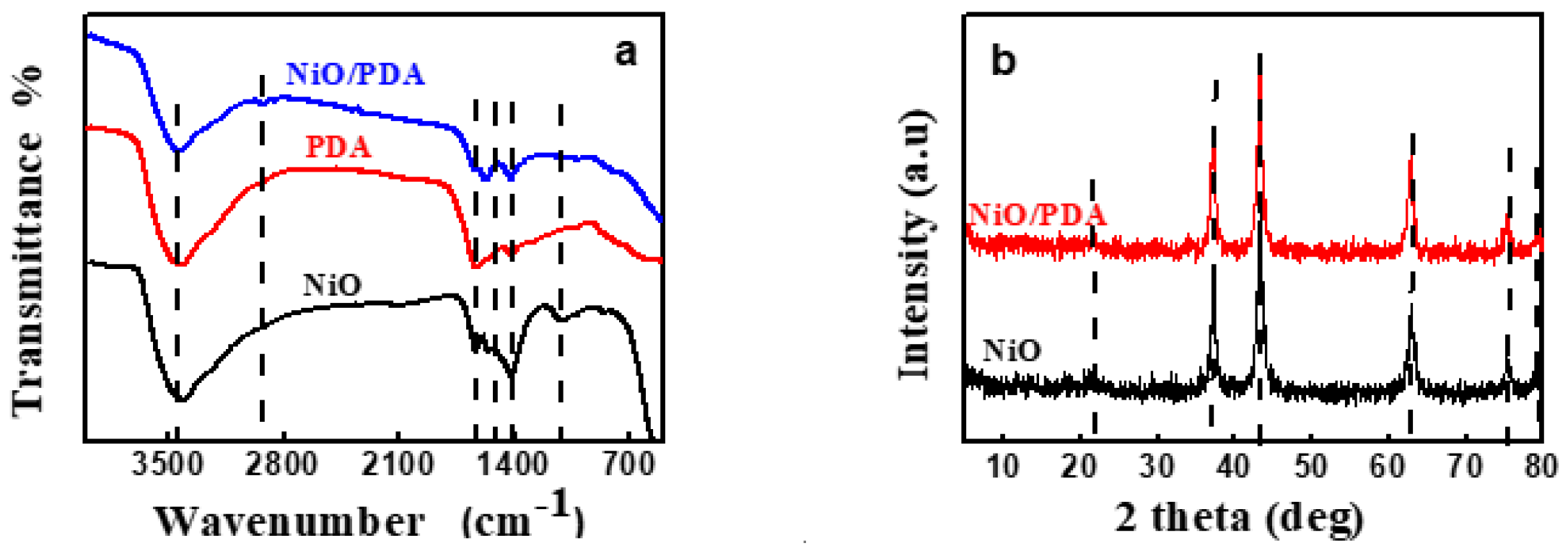
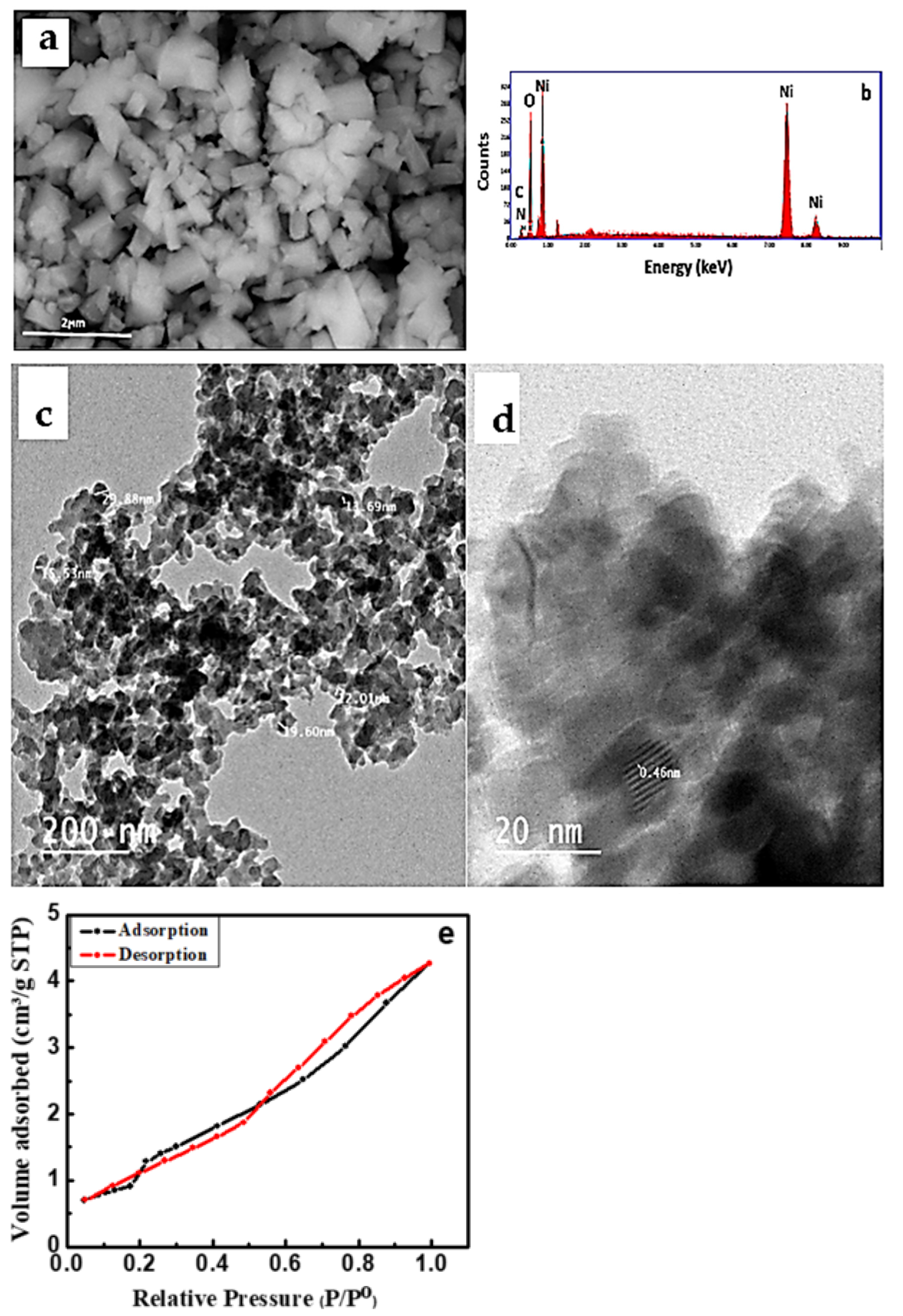
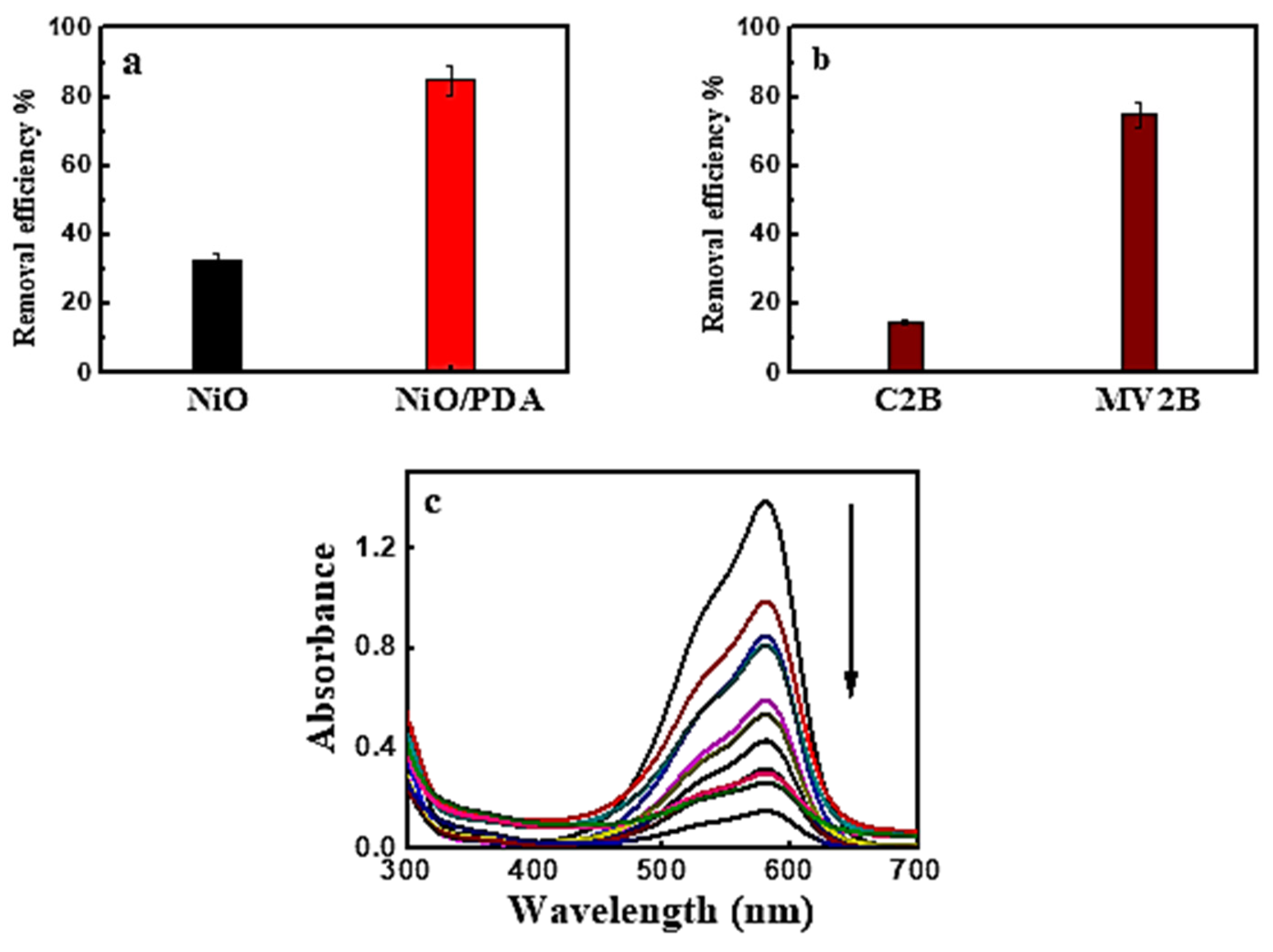
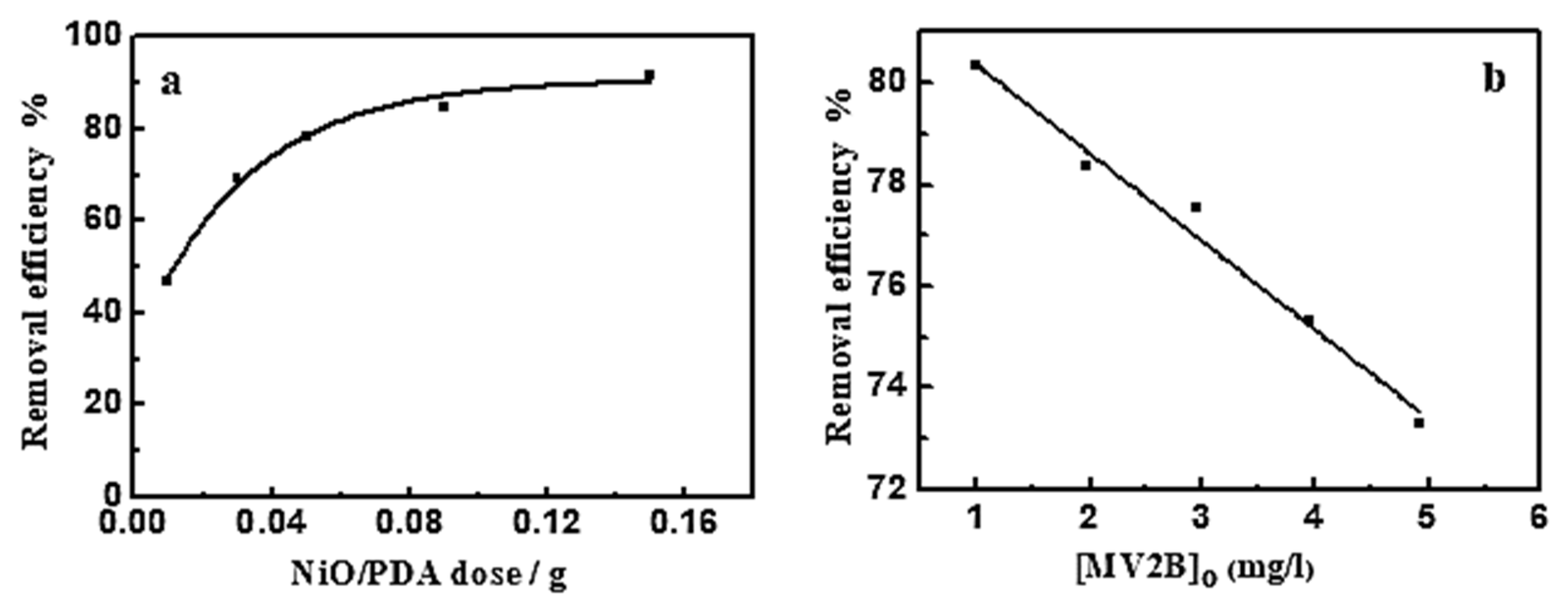
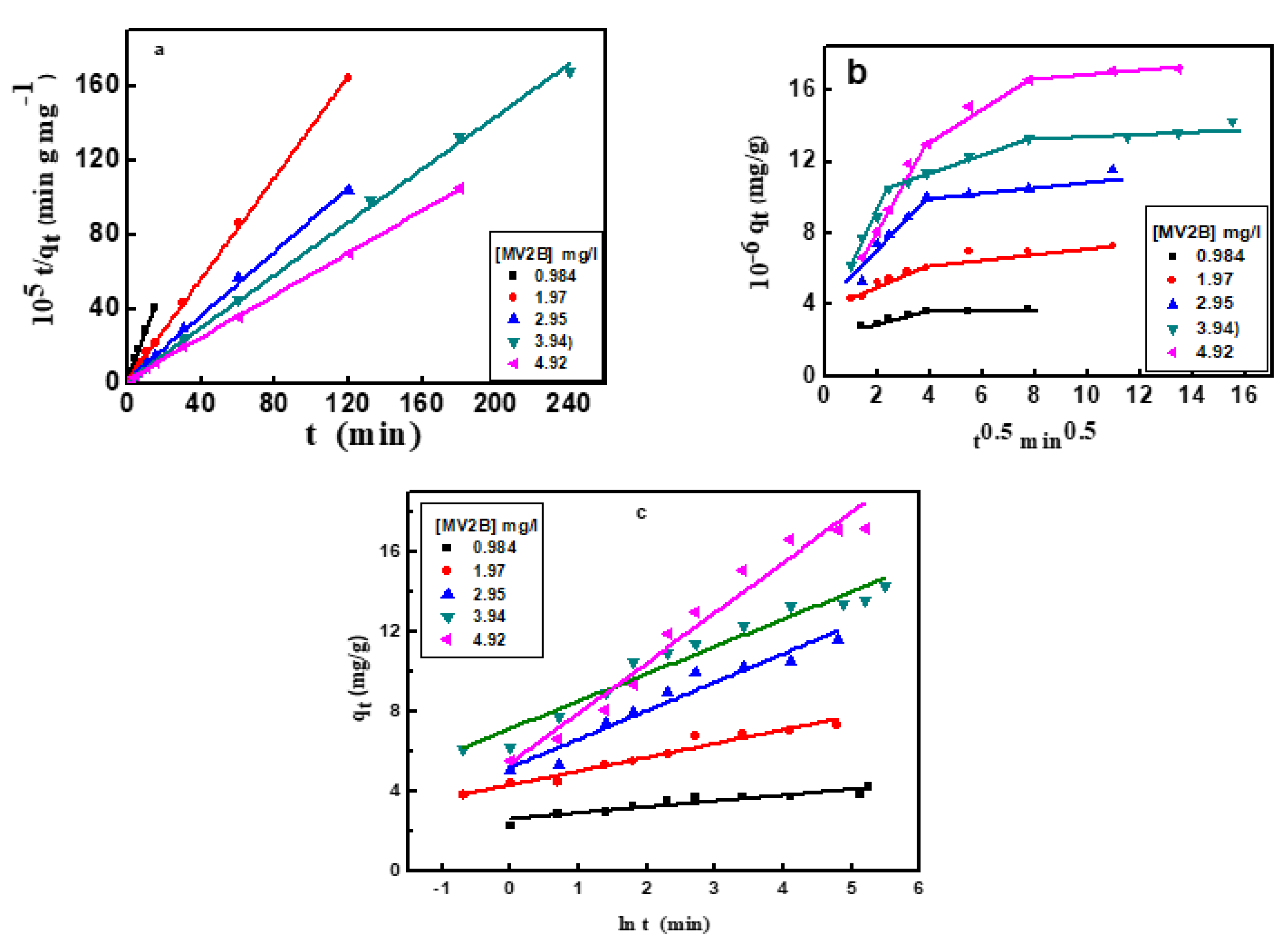
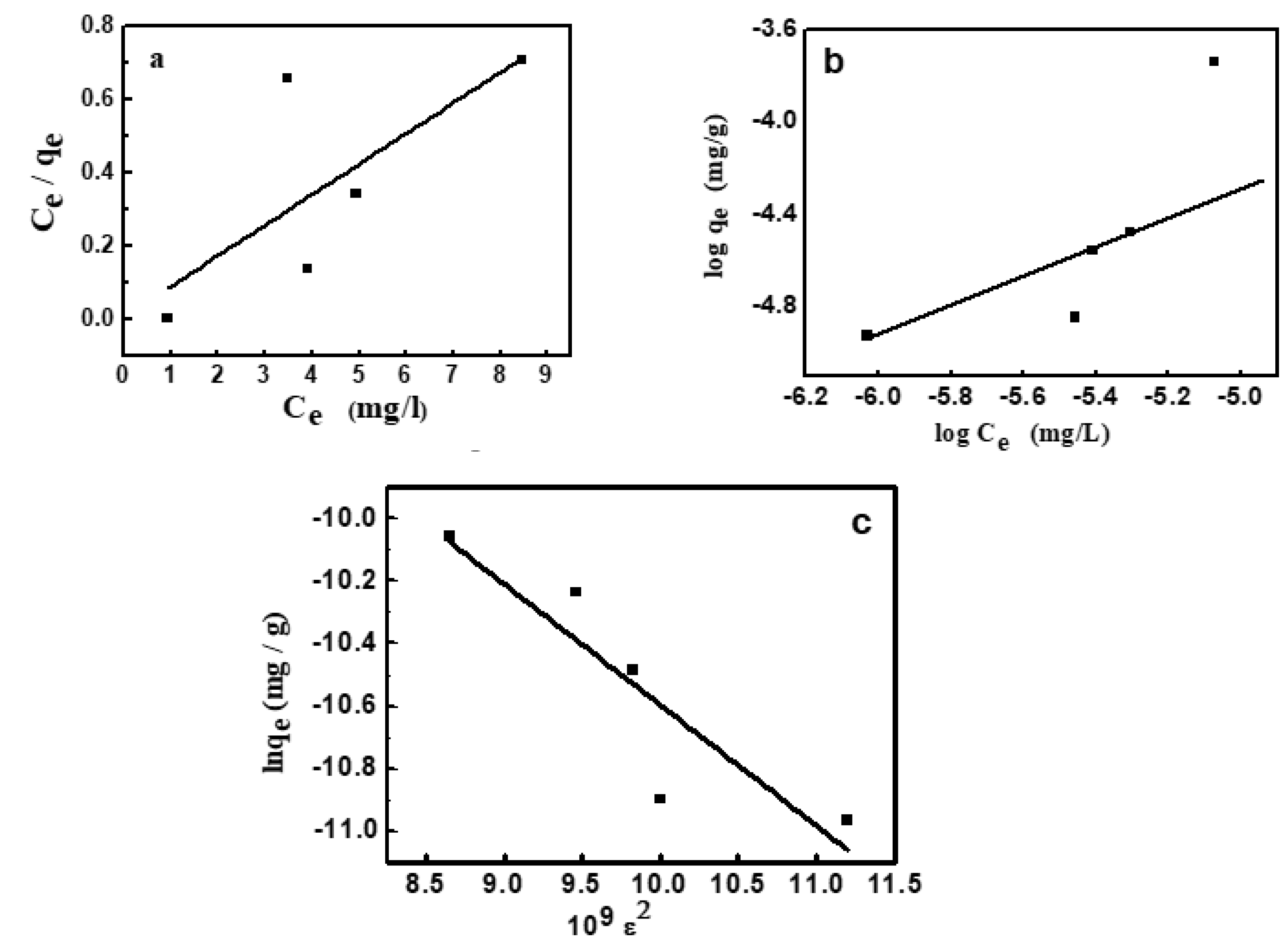
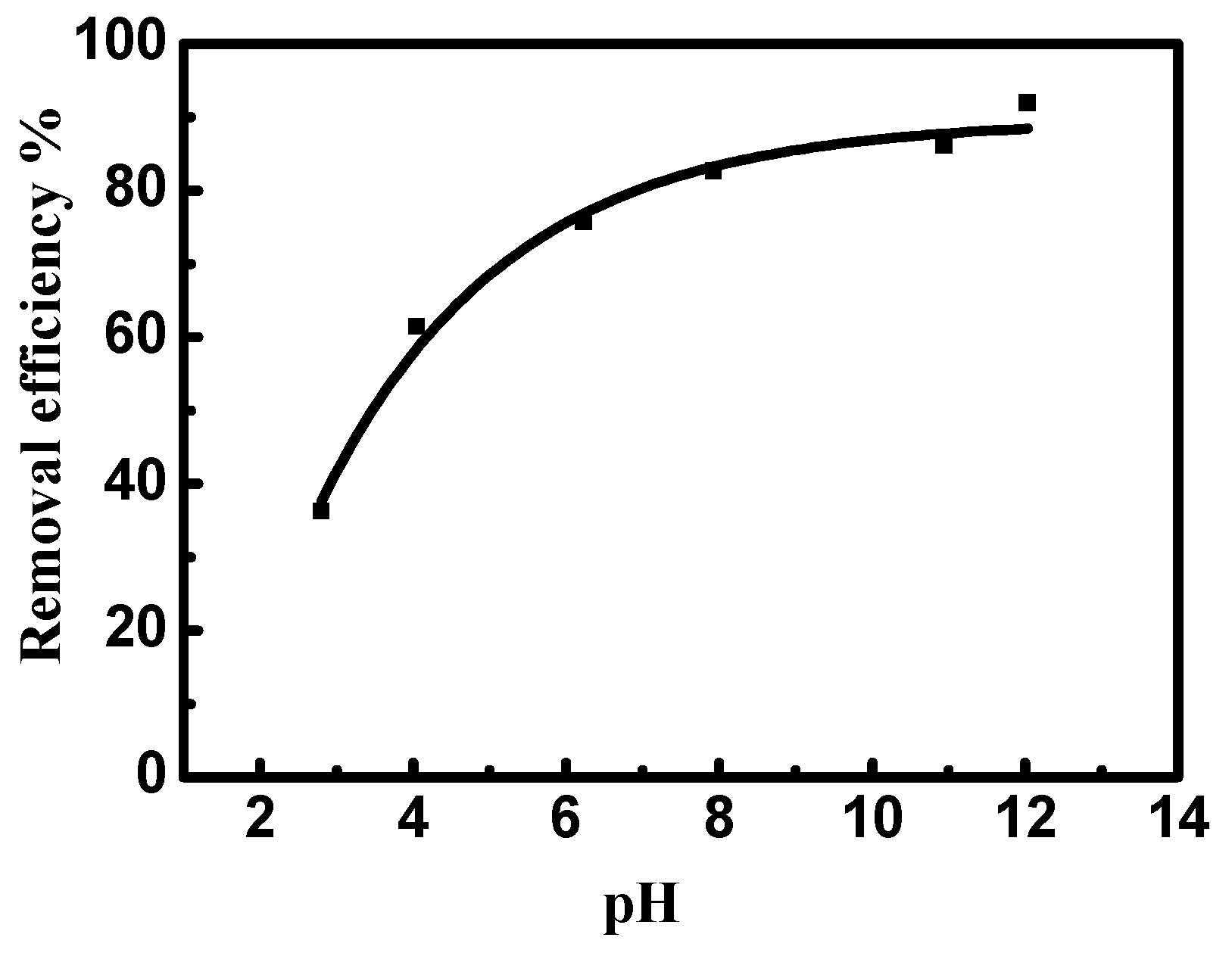
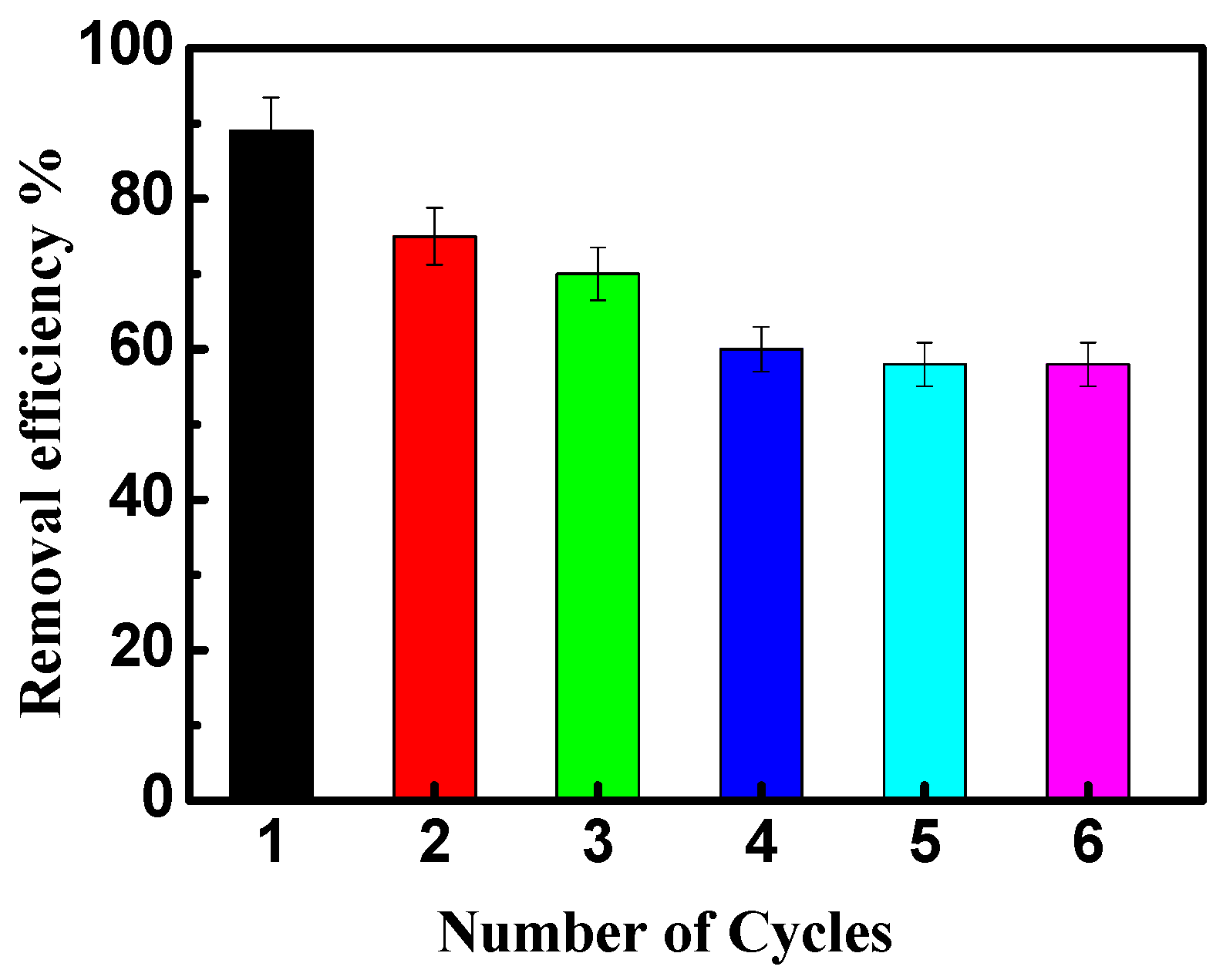
| Elements | Weight % |
|---|---|
| C | 8.62 |
| N | 0.81 |
| O | 18.74 |
| Ni | 71.83 |
| (MV2B)o mg/L | Pseudo-First-Order Model | Pseudo-Second-Order Model | Intraparticle Diffusion Model | Elovich | |||||||||||
|---|---|---|---|---|---|---|---|---|---|---|---|---|---|---|---|
| qe.cal mgg−1 | qe.exp mglg−1 | k1 min−1 | R2 | qe.cal mgg−1 | qe.exp mgg−1 | k2 g mg−1 min−1 | R2 | kp1 mg g−1 min−1 | R2 | kp2 mg g−1 min−1/2 | R2 | α mg g−1 min−1 | Β g.mg−1 | R2 | |
| 0.984 | 0.212 | 1.799 | 4.7262 | 0.7255 | 0.212 | 0.3808 | 0.6425 | 0.9982 | 0.3546 | 0.9584 | 0.0153 | 0.980 | 9.25 | 3.3823 | 0.854 |
| 1.972 | 0.747 | 3.878 | 1.0423 | 0.9103 | 0.747 | 0.7342 | 0.2534 | 0.9994 | 0.6285 | 0.9324 | 0.1758 | 0.900 | 81.65 | 1.4502 | 0.947 |
| 2.953 | 1.243 | 2.223 | 0.0027 | 0.8399 | 1.243 | 1.1763 | 0.5626 | 0.9979 | 1.7636 | 0.9279 | 0.1293 | 0.999 | 216.32 | 0.7293 | 0.954 |
| 3.942 | 1.434 | 5.482 | 0.0133 | 0.6675 | 1.434 | 1.4142 | 1.0053 | 0.9985 | 2.8335 | 0.9819 | 0.5317 | 0.990 | 715.31 | 0.7017 | 0.934 |
| 4.923 | 1.716 | 1.433 | 0.4322 | 0.8638 | 1.716 | 1.7623 | 1.2877 | 0.9996 | 2.7012 | 0.9812 | 0.9117 | 0.925 | 1354.92 | 0.3974 | 0.961 |
| Isotherm | Parameters | Value |
|---|---|---|
| Langmuir | qm | 12. 04 mgg−1 |
| KL | 7.1347 Lmg−1 | |
| R2 | 0.9750 | |
| RL | 0.0453 | |
| Freundlich | KF | 2.4434 Lmg−1 |
| 1/n | 1.3044 | |
| N | 0.767 | |
| R2 | 0.9567 | |
| Dubinin–Radushkevich | E | 35.958 kJmol−1 |
| R2 | 0.890 |
Publisher’s Note: MDPI stays neutral with regard to jurisdictional claims in published maps and institutional affiliations. |
© 2022 by the authors. Licensee MDPI, Basel, Switzerland. This article is an open access article distributed under the terms and conditions of the Creative Commons Attribution (CC BY) license (https://creativecommons.org/licenses/by/4.0/).
Share and Cite
El-Ghobashy, M.A.; Hashim, H.; Darwish, M.A.; Khandaker, M.U.; Sulieman, A.; Tamam, N.; Trukhanov, S.V.; Trukhanov, A.V.; Salem, M.A. Eco-Friendly NiO/Polydopamine Nanocomposite for Efficient Removal of Dyes from Wastewater. Nanomaterials 2022, 12, 1103. https://doi.org/10.3390/nano12071103
El-Ghobashy MA, Hashim H, Darwish MA, Khandaker MU, Sulieman A, Tamam N, Trukhanov SV, Trukhanov AV, Salem MA. Eco-Friendly NiO/Polydopamine Nanocomposite for Efficient Removal of Dyes from Wastewater. Nanomaterials. 2022; 12(7):1103. https://doi.org/10.3390/nano12071103
Chicago/Turabian StyleEl-Ghobashy, Marwa A., Hisham Hashim, Moustafa A. Darwish, Mayeen Uddin Khandaker, Abdelmoneim Sulieman, Nissren Tamam, Sergei V. Trukhanov, Alex V. Trukhanov, and Mohamed A. Salem. 2022. "Eco-Friendly NiO/Polydopamine Nanocomposite for Efficient Removal of Dyes from Wastewater" Nanomaterials 12, no. 7: 1103. https://doi.org/10.3390/nano12071103








